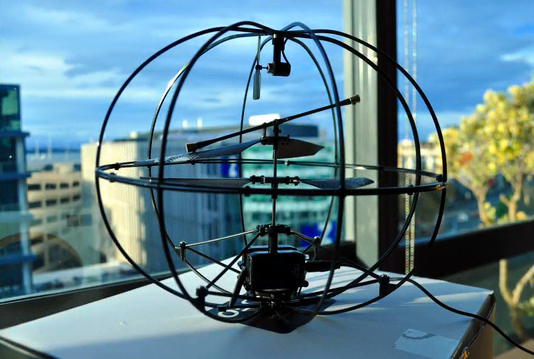A group called Puzzlebox is hoping to teach kids about neuroscience, open source coding, and focus, by luring them in with a spherical toy helicopter controlled by brainwaves.

Puzzlebox has been developing open source code to turn EEG signals picked up basic, commercially sold EEG tracking headbands into instructions a robot can understand. Over the last two years they’ve wooed and wowed school kids with headset-controlled toy land robots and video games, and regular remote-controlled model helicopters hacked to interface with EEG-reading headsets. They tend to share their code and designs.
But the Orbit helicopter is the first product they’re planning to sell. The project’s Kickstarter campaign to fund manufacturing has already collected twice the target goal of $10,000, with more than half their campaign still to go.
The Orbit’s distinctive shell is designed to protect its blades when it whams into walls or the ceiling, Puzzlebox explains. The helicopter shares a Bluetooth connection with a Mindwave Mobile EEG headset made by NeuroSky, the company that is also behind the Necomimi robotic ears.
By linking moods with flight instructions to “mood” patterns picked up by the EEG headset, a person wearing the headset can cause the Orbit to fly forward or higher.
The Orbit helicopter can be controlled using just the headset, a smartphone, and Puzzlebox mobile software. An optional third piece is the Puzzlebox “Pyramid,” a remote control system that collects data read by the headset. The Pyramid reflects the “mood” of the person wearing the headset by a ring of colored lights on its front face. You can also choose flight commands that will go along with a certain mood.

If fully backed, Puzzlebox plans to share the design and software that makes Orbit fly, so others can replicate or build on. Educating college ands school kids has always been a priority, and the Orbit is no exception. Puzzlebox claims that “Any interested high school or college student should be able to access and extend our software and designs.”
Keep Reading
Most Popular
Large language models can do jaw-dropping things. But nobody knows exactly why.
And that's a problem. Figuring it out is one of the biggest scientific puzzles of our time and a crucial step towards controlling more powerful future models.
The problem with plug-in hybrids? Their drivers.
Plug-in hybrids are often sold as a transition to EVs, but new data from Europe shows we’re still underestimating the emissions they produce.
Google DeepMind’s new generative model makes Super Mario–like games from scratch
Genie learns how to control games by watching hours and hours of video. It could help train next-gen robots too.
How scientists traced a mysterious covid case back to six toilets
When wastewater surveillance turns into a hunt for a single infected individual, the ethics get tricky.
Stay connected
Get the latest updates from
MIT Technology Review
Discover special offers, top stories, upcoming events, and more.